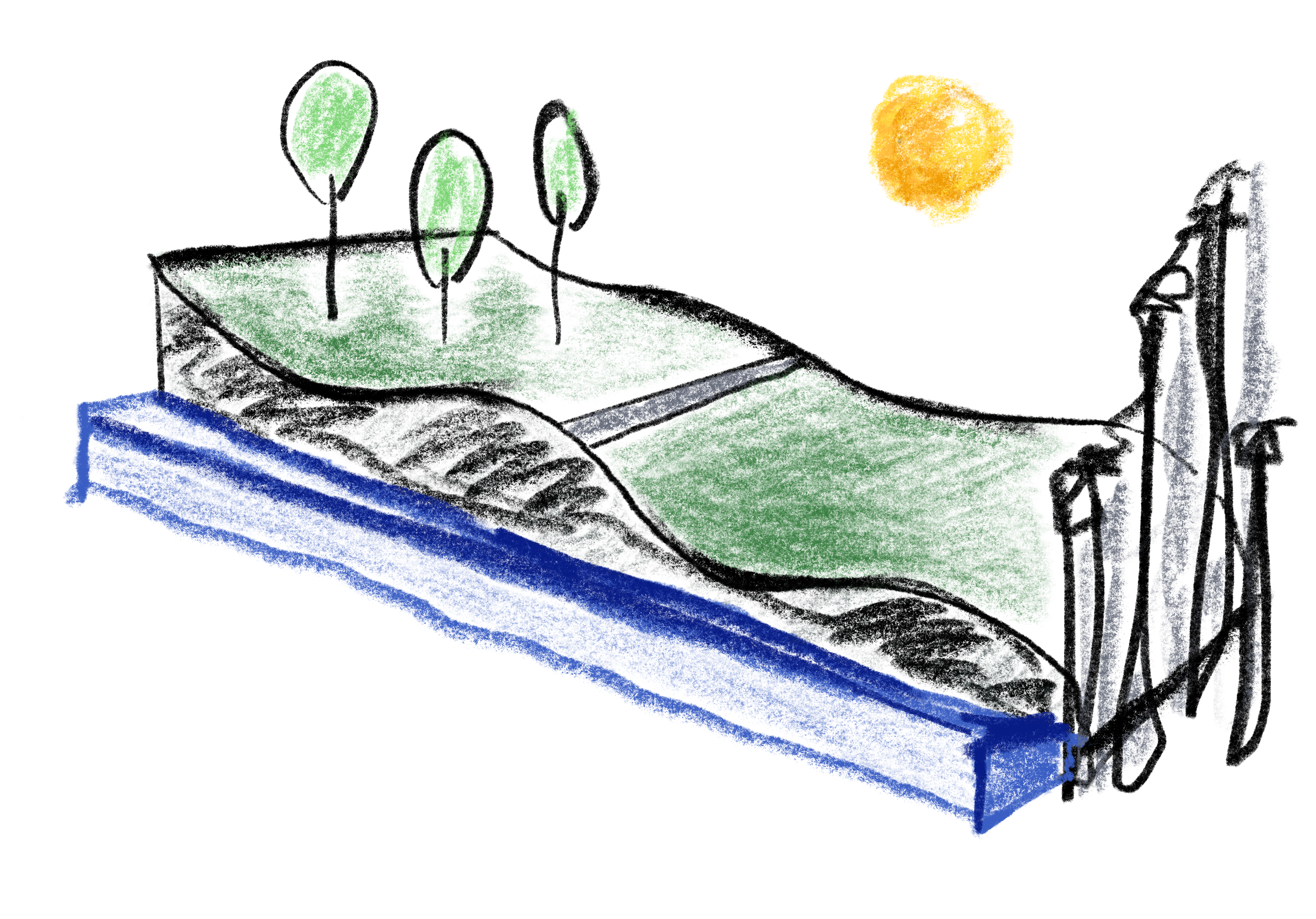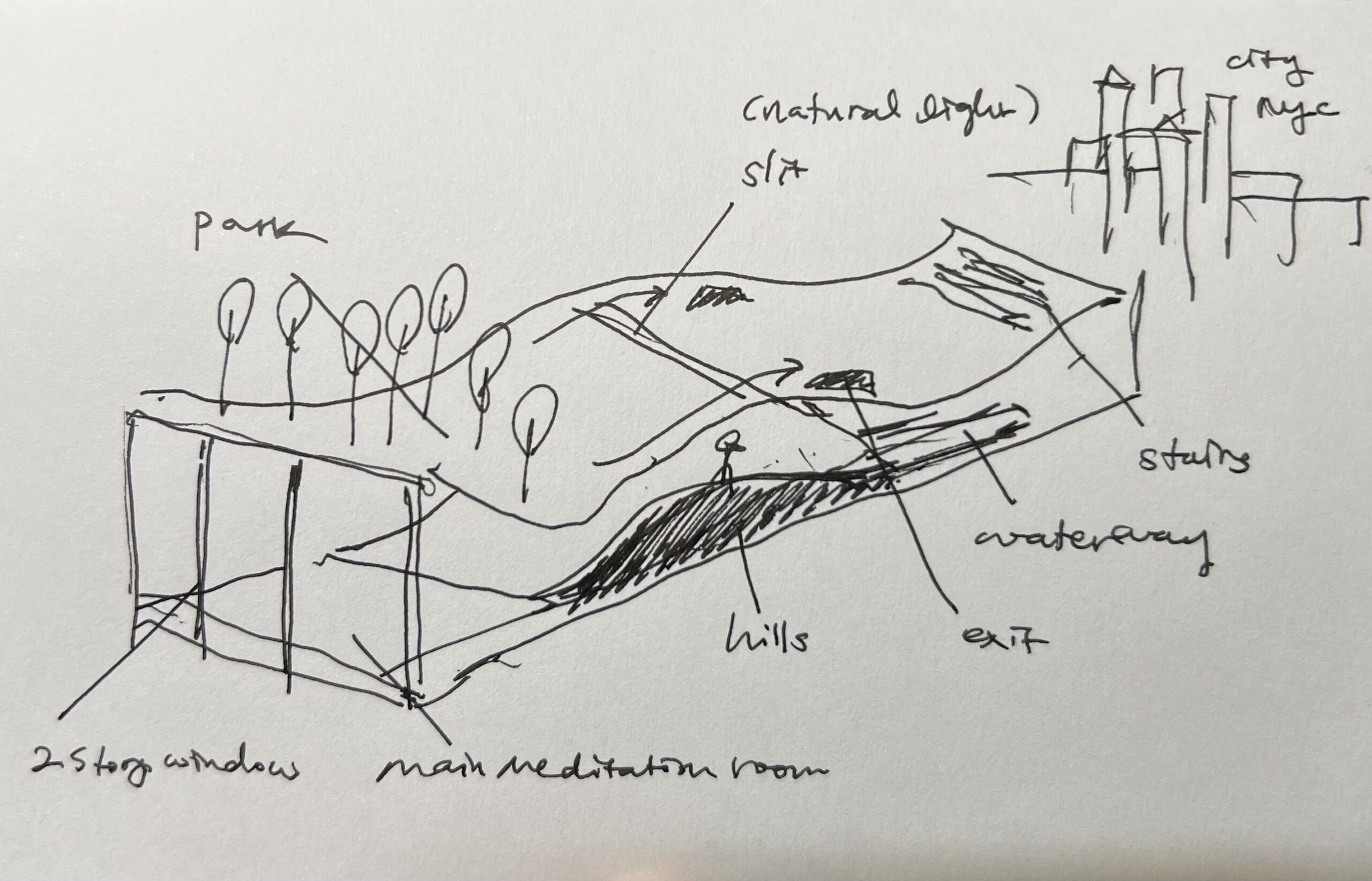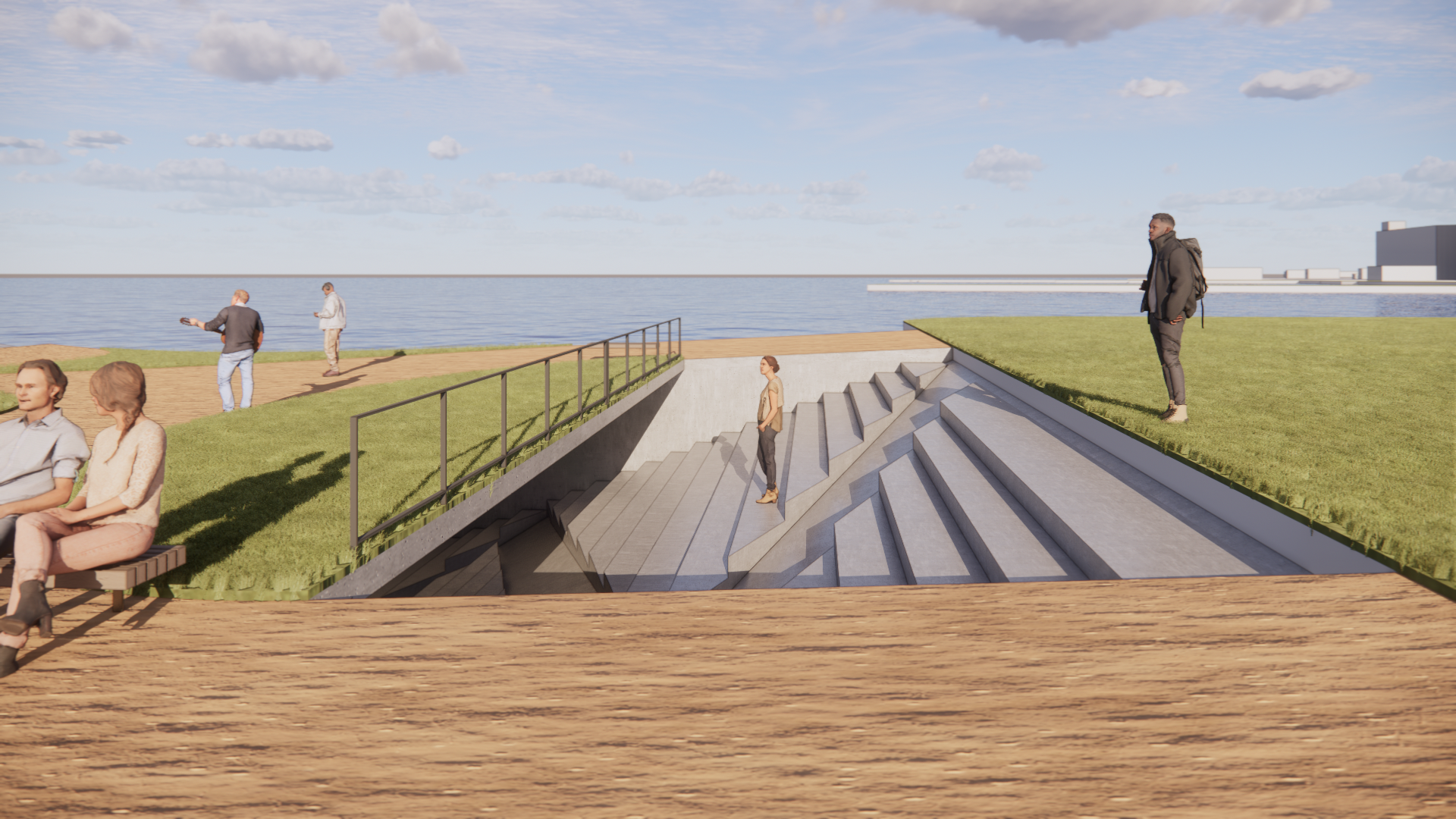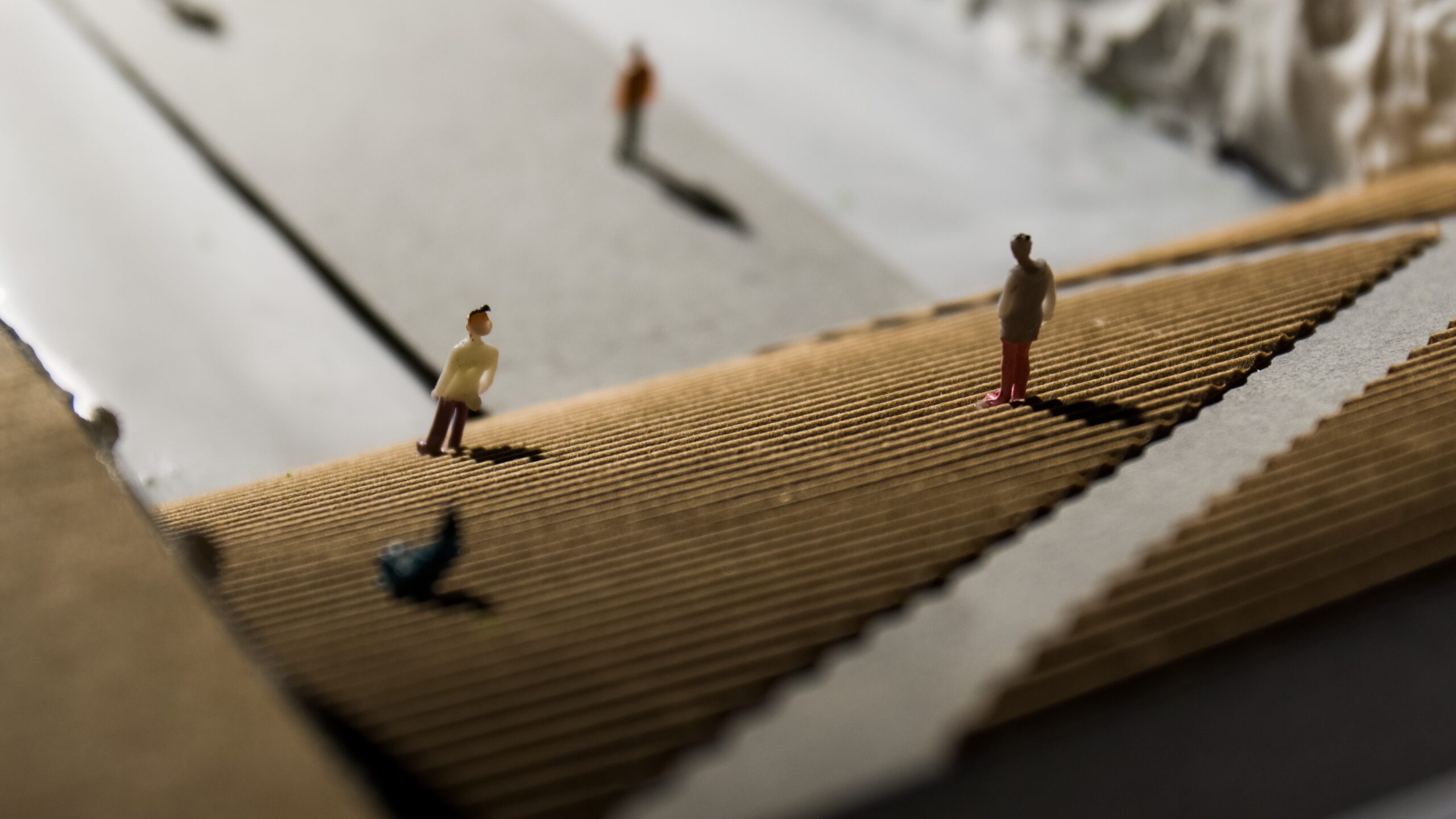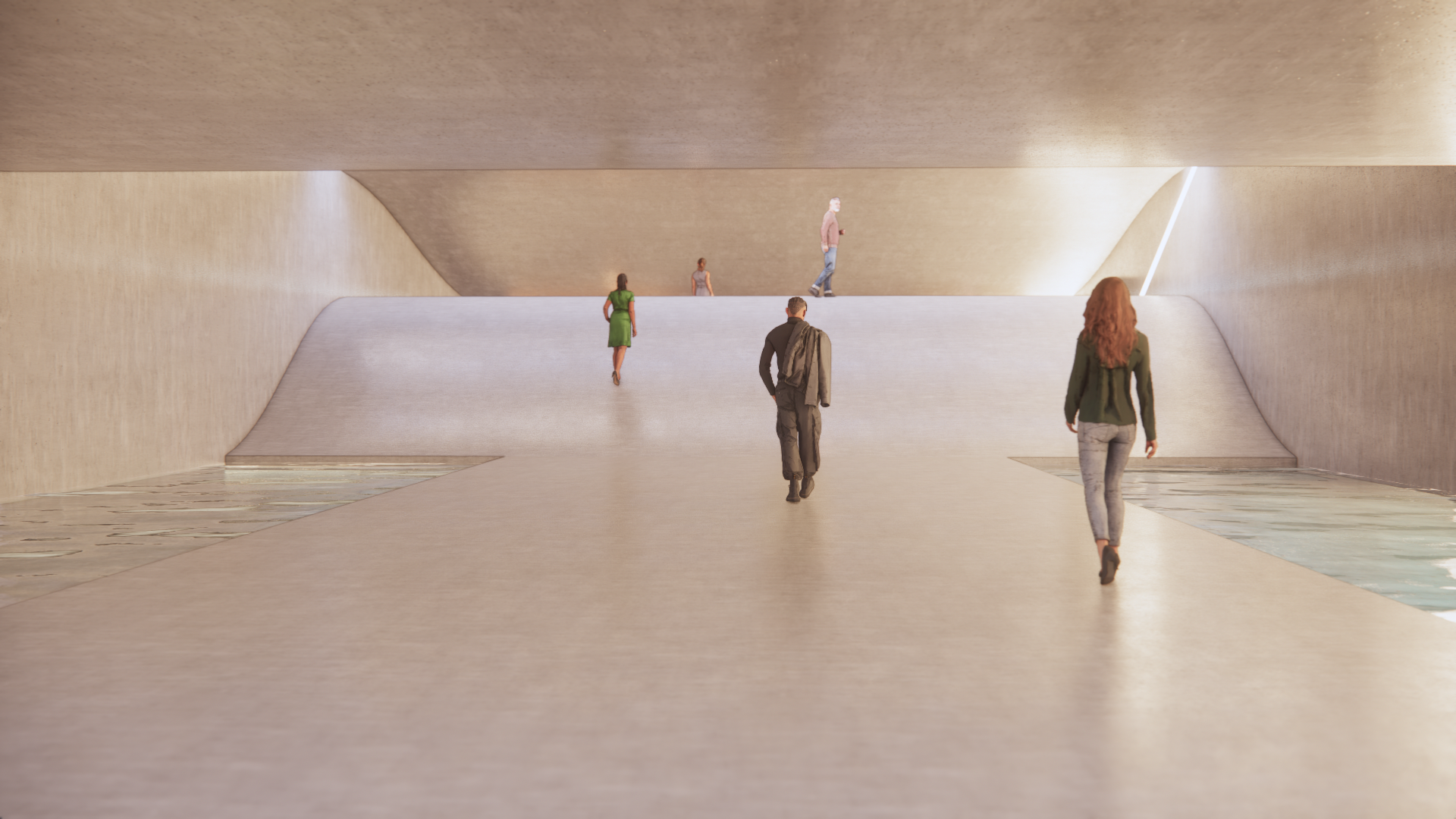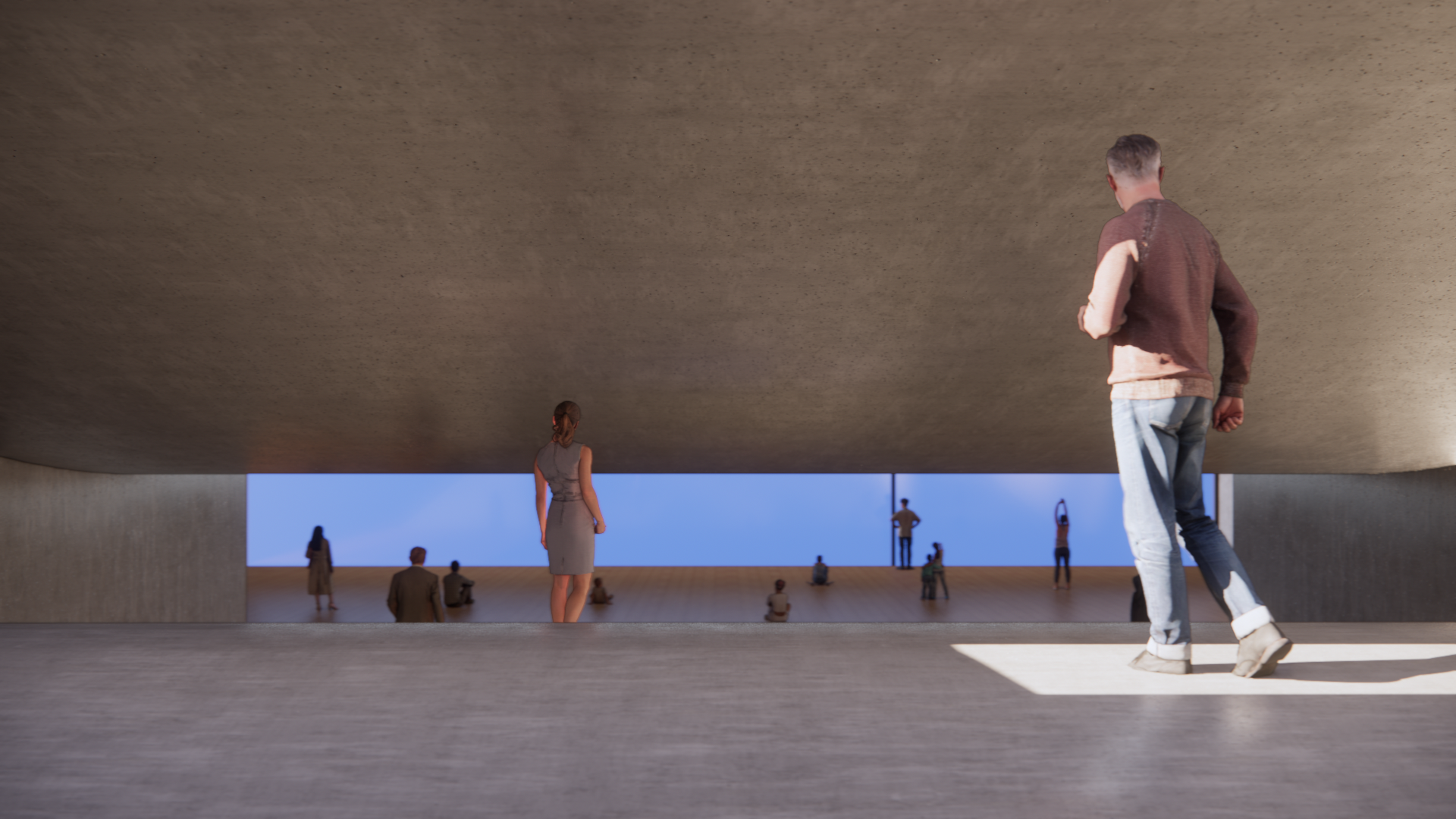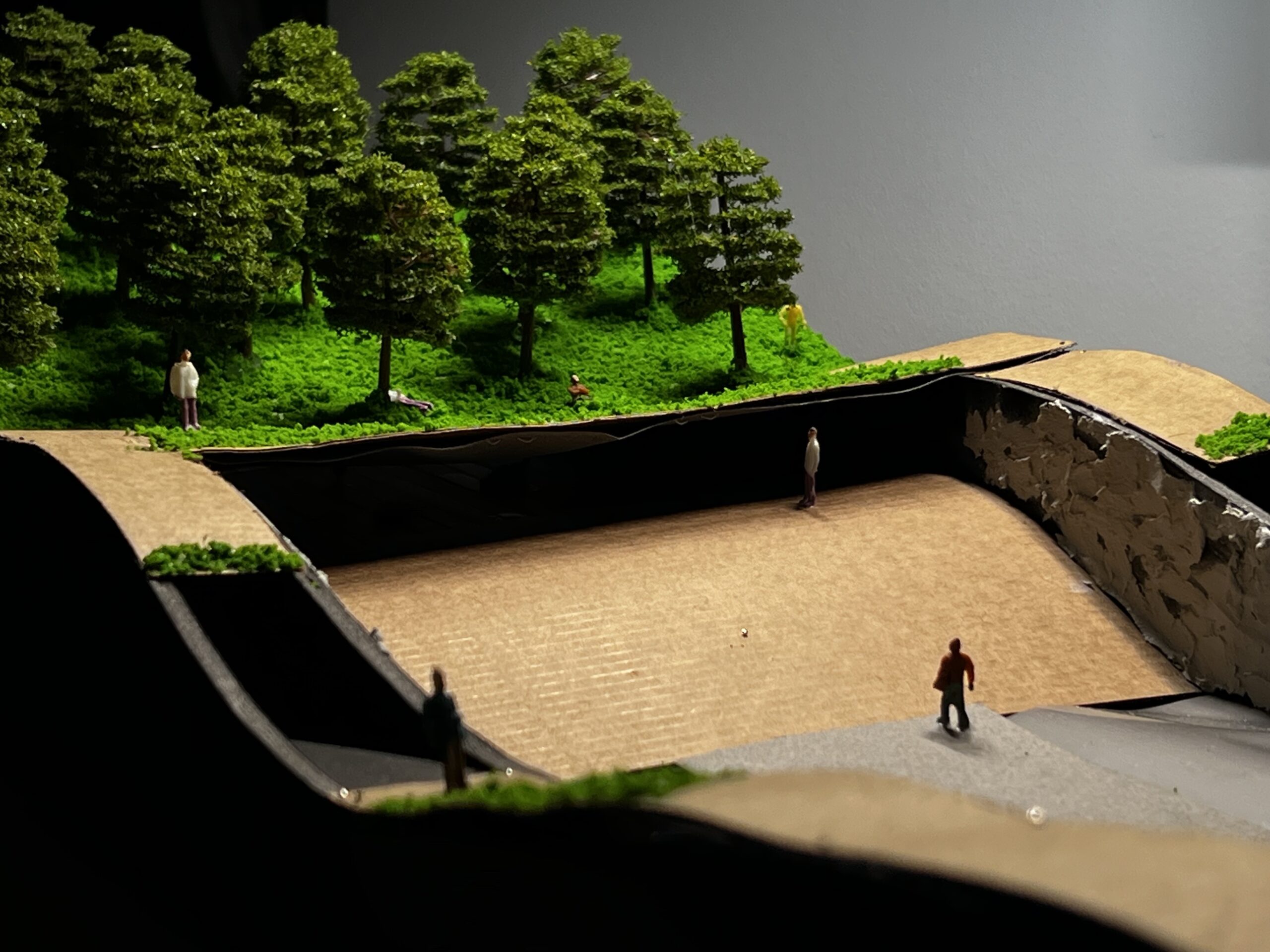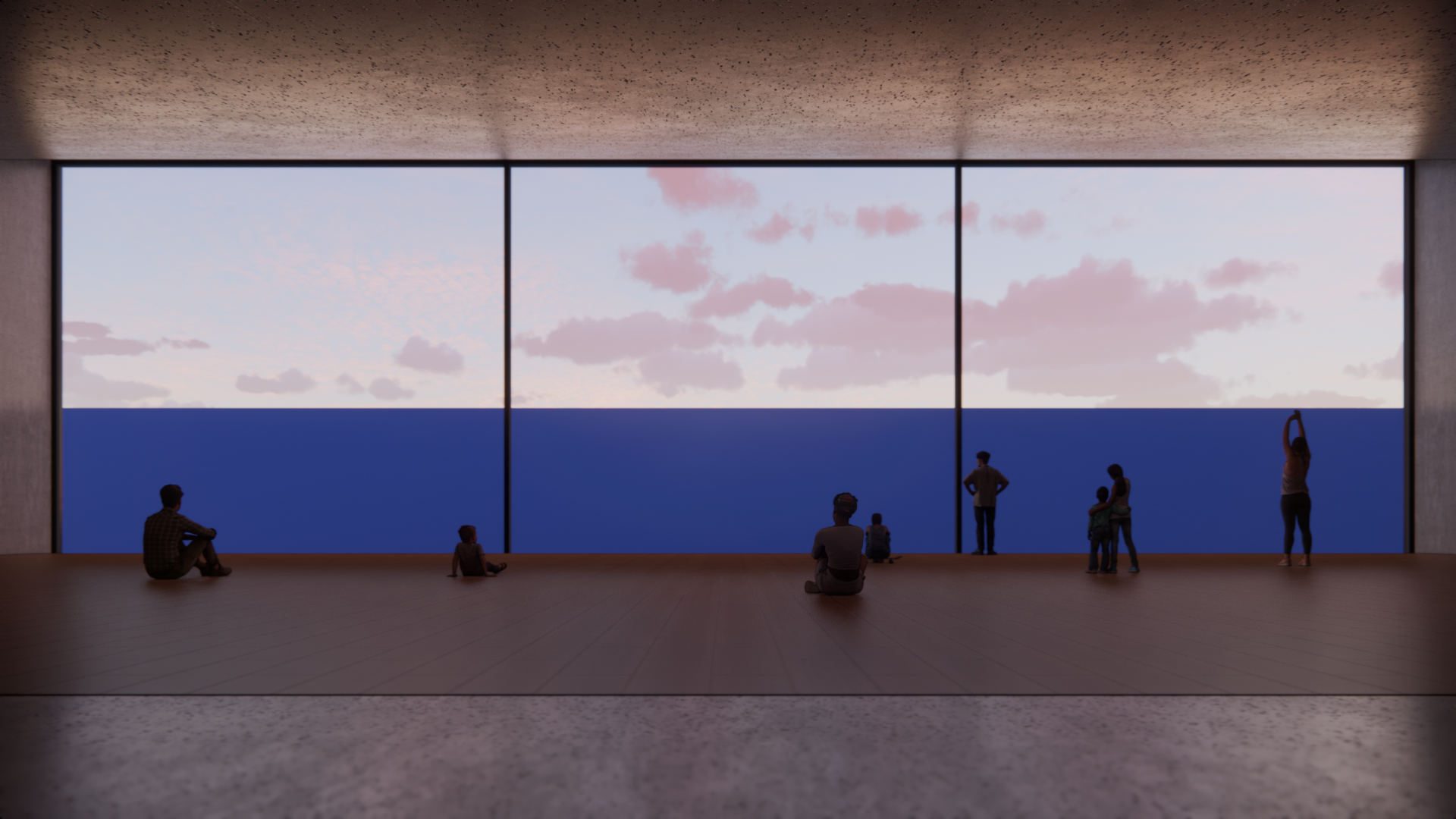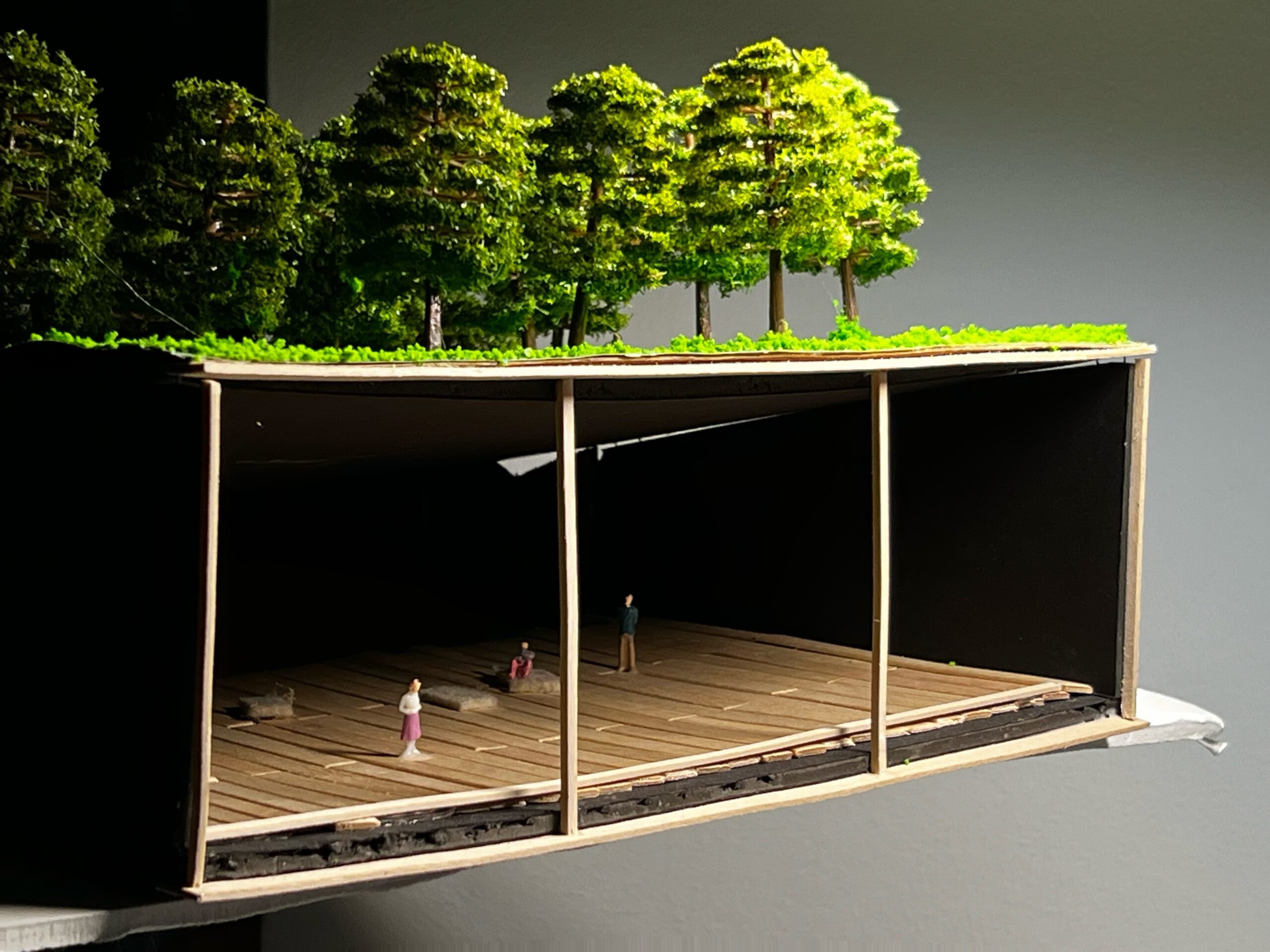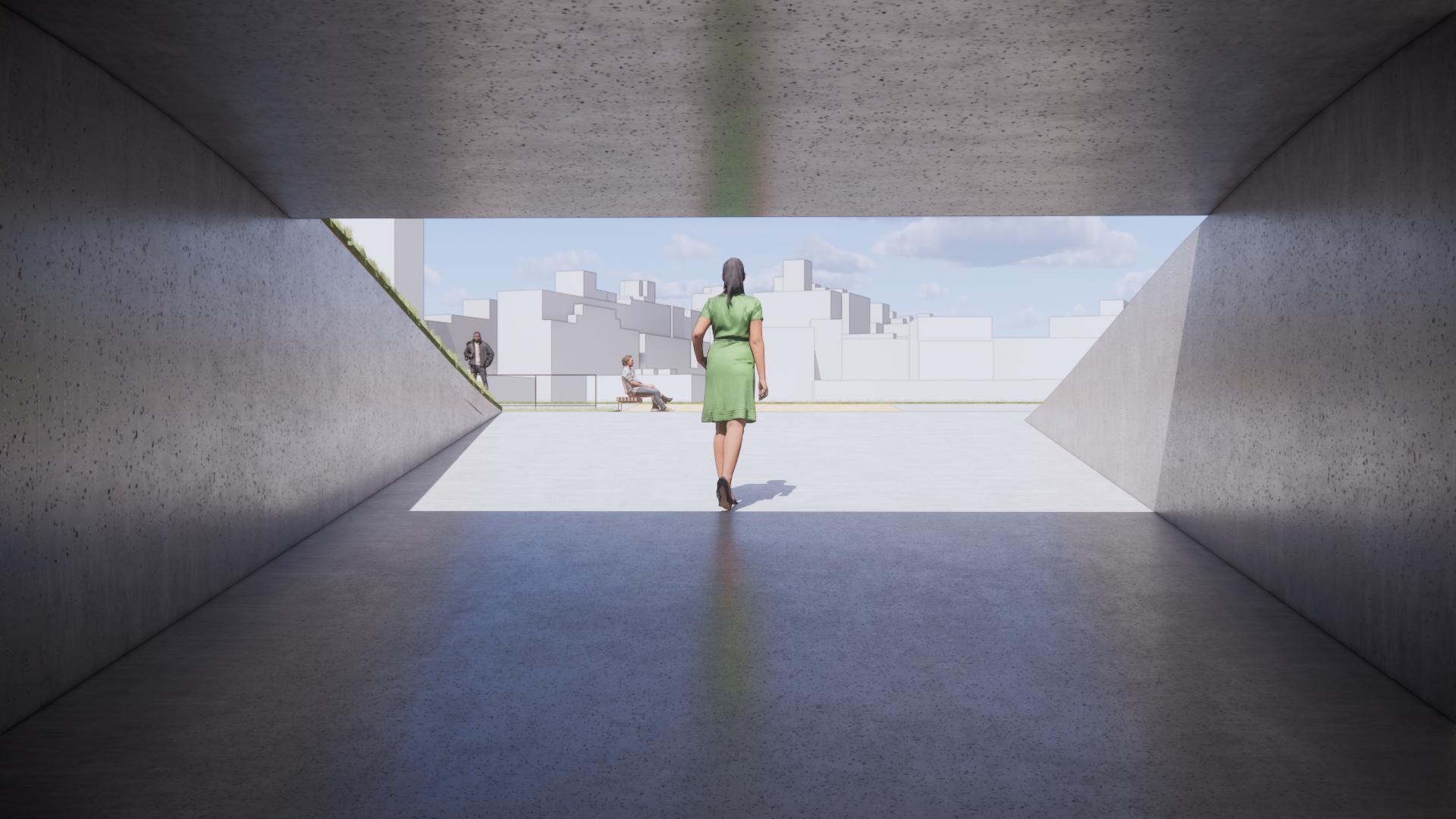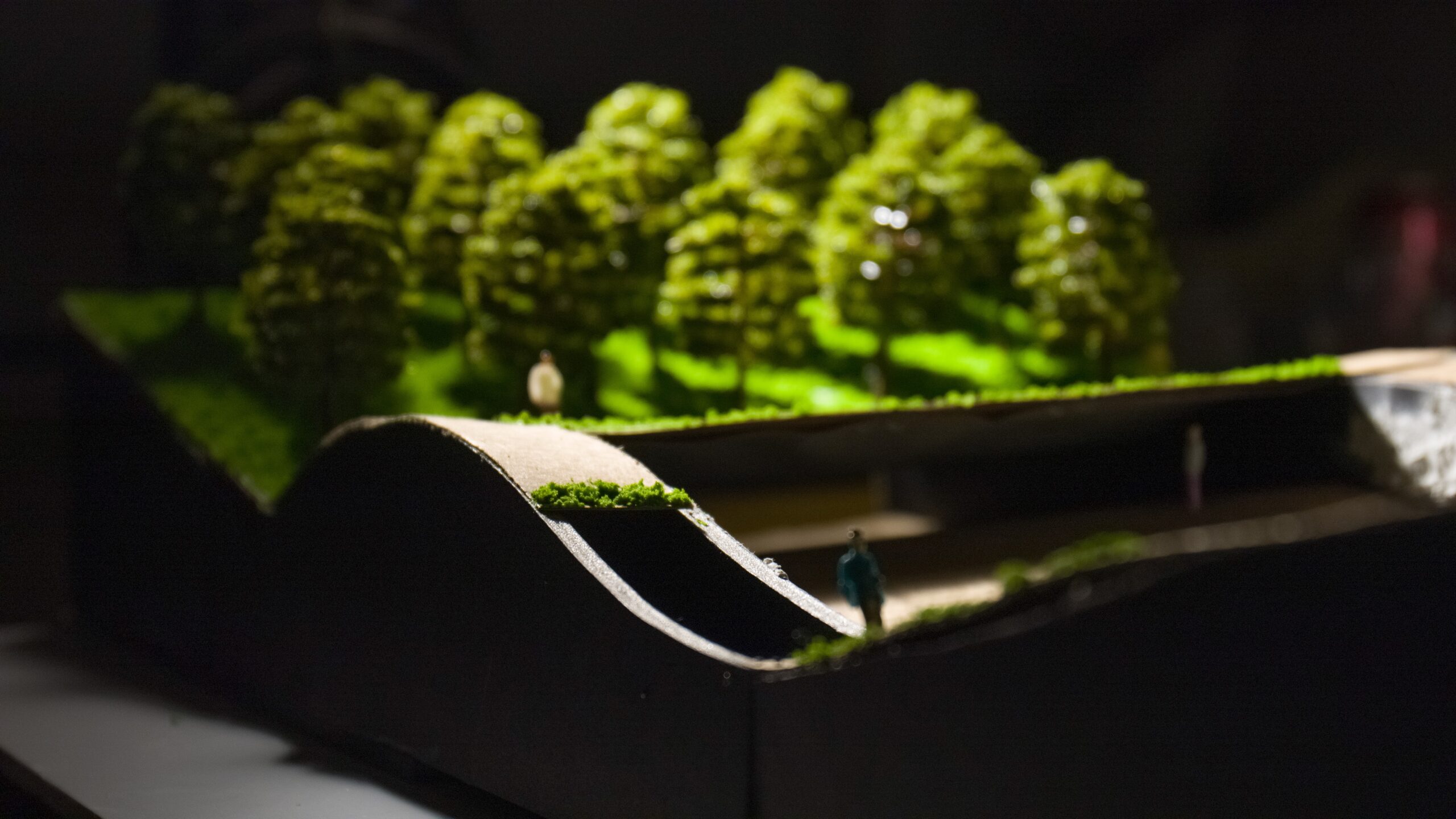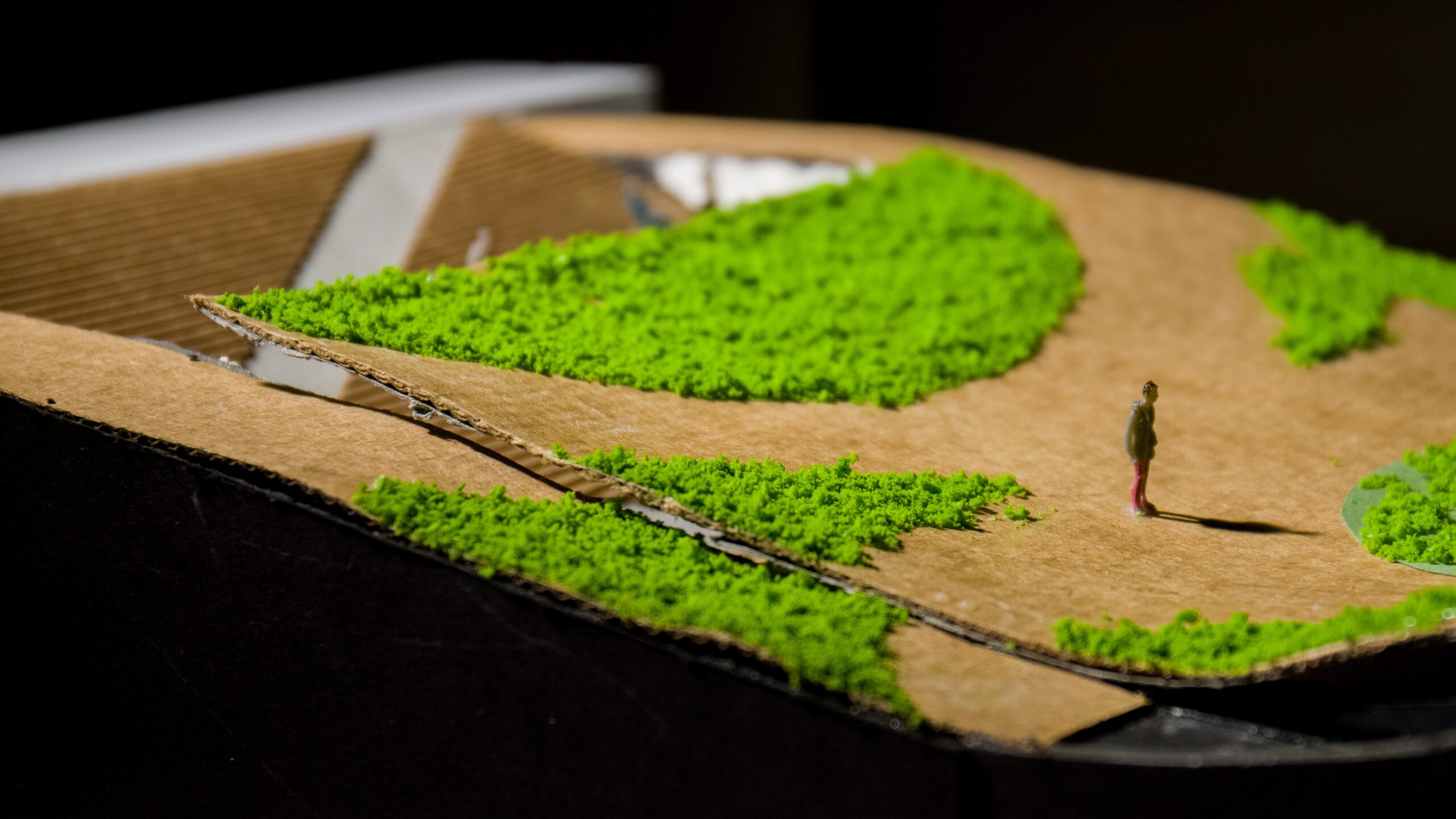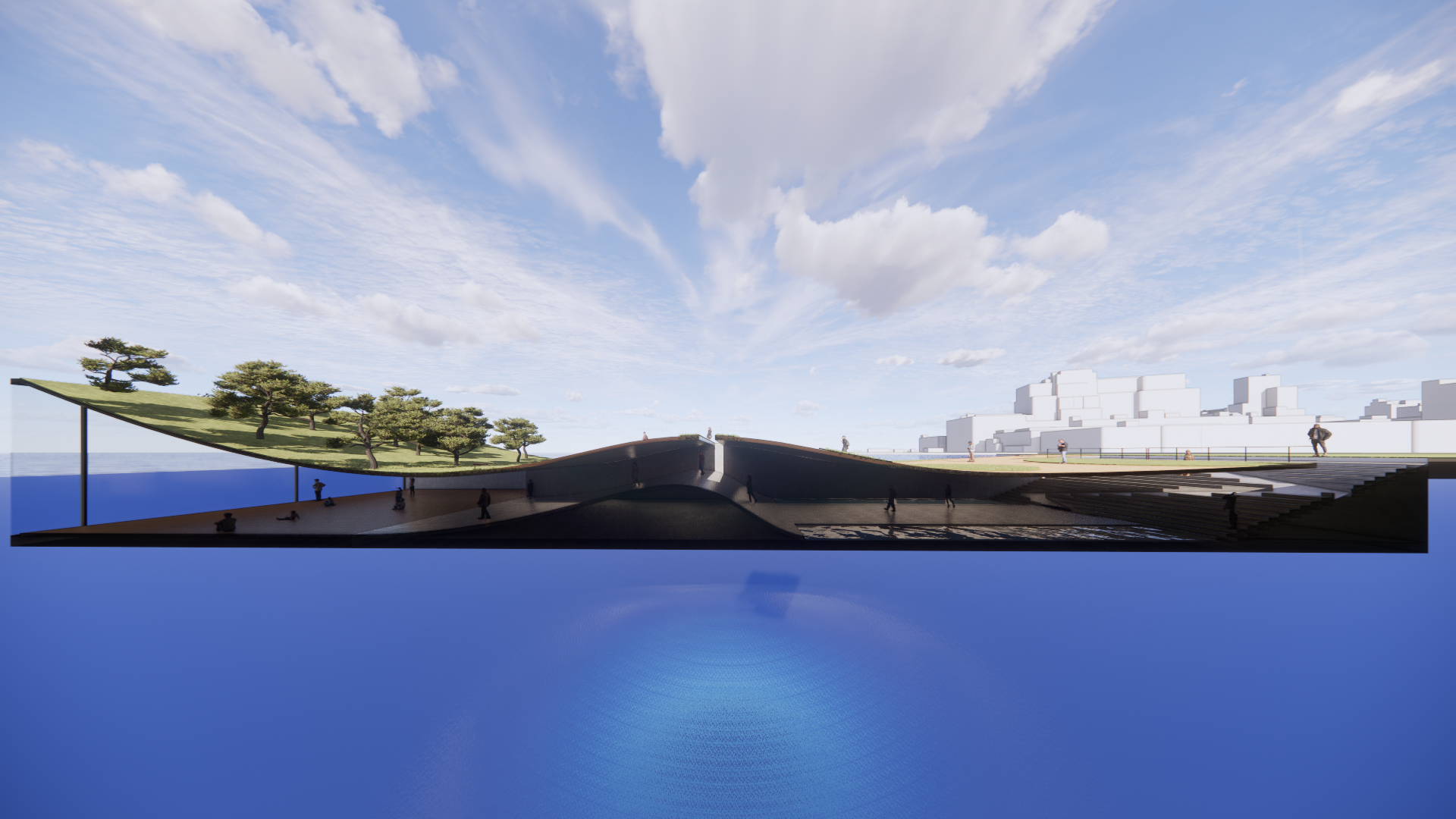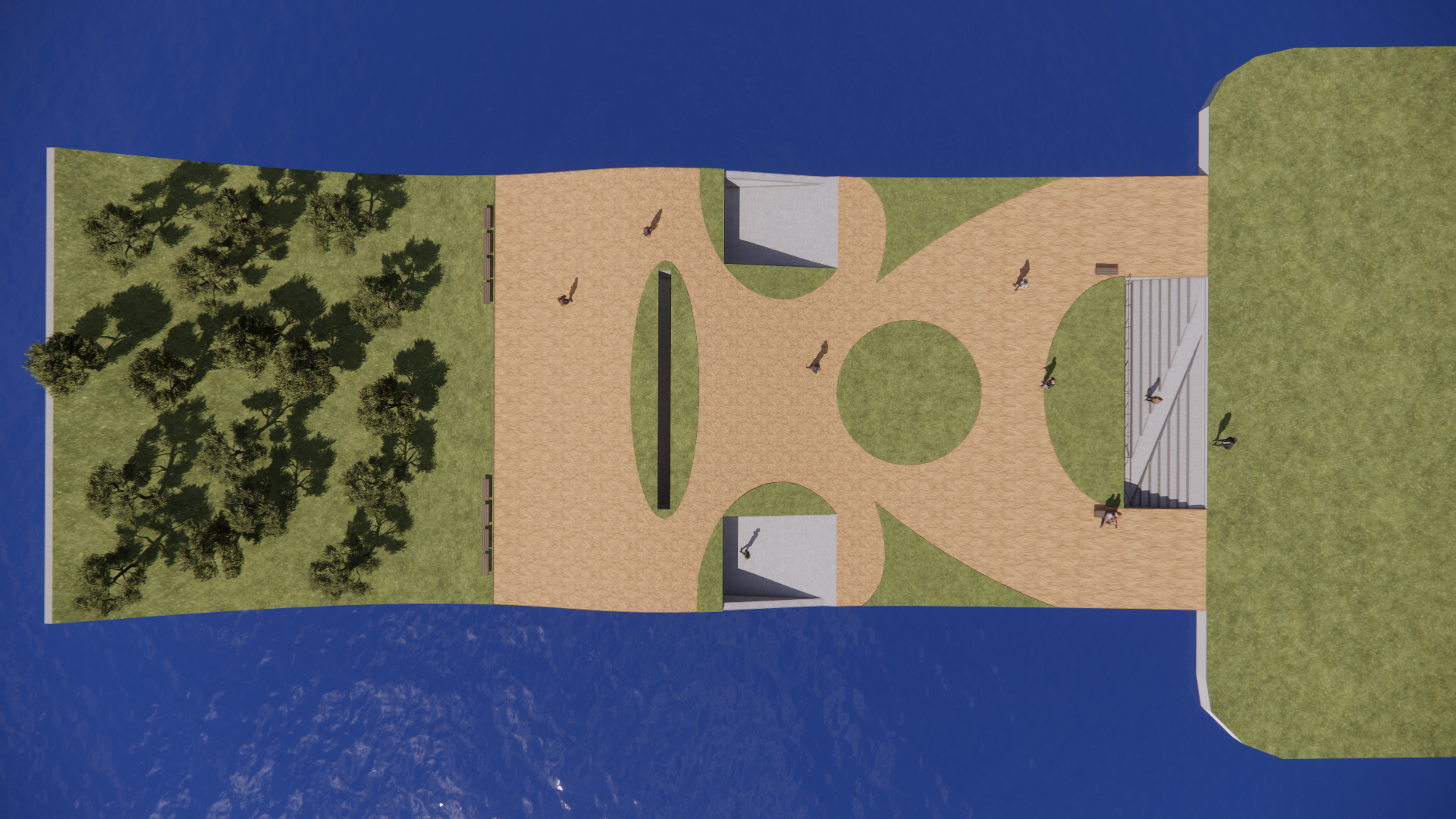Beyond its narrative of New Yorkers seeking new dreams, the structure fulfills its purpose as a rehabilitation center for the human spirit.
In Counter
A Wave Meditation Room at Pier 62 NYC
“Architecture as Narrative” delved into architectural design through narrative. We were tasked with gradually expanding our designs from a small room to more diverse spaces, incorporating an entrance, transitional areas, and ultimately completing the entire building through a unique narrative we aimed to showcase.
As our group’s members were all international students with diverse backgrounds—Rowan & Jiwoo from South Korea, Kevin from Canada, and Pietro from Croatia—gathering in New York to pursue our unique goals, we envisioned creating a space for diversity. The softest blending space for diverse people we could think of was a space for group activities, including a meditation room. We linked the concept of group activity with personal journeys in New York City, aligning with our own journeys in the city. “A space for modern people’s mindfulness, anyone seeking inner peace through meditation” became our starting logline.
Architecturally, our goal was to transform spaces into modern, user-friendly, awe-inspiring environments that could awaken people’s dormant spiritual energy. Our key design concept aimed to allow users to experience a sense of sublimity through forms combining geometric and naturalistic elements, creating a contrast between open and enclosed spaces to enhance the enjoyment of natural light.
Since the building was predestined for Manhattan, we chose one of the piers along the Manhattan perimeter. Three reasons guided this choice. Firstly, to revitalize underused pier areas for the community’s economic and cultural benefit. Pier 62, connected to the spacious Hudson River Park, held great potential. Secondly, integrating resilient design features in the water-surging area would offer an environmentally pioneering aspect to the city. Lastly, it completed our narrative of architecture—a space to meditate outside a complex city.
Our inspiration came from various sources. The underwater restaurant UNDER by architectural firm Snohetta inspired the idea of our structure being half submerged and half surfaced. Designer Maya Lin’s Wave Field and architect Junya Ishigami’s KAIT Plaza influenced our wavy hallway hill and ceiling, creating a wavy park. Film director Denis Villeneuve’s Blade Runner 2049 served as our paramount inspiration, particularly through its depiction of the main antagonist’s office/lab, which is infused with water elements. This concept resonated with our vision for a waterside meditation room. The name of our building is In-Counter. It exudes a punk and rebellious characteristic, representing the counter-world, counter-culture, and counter-space. We considered our above ground hometowns as the main world and cultural space, making our underground architecture projecting onto New York City a counter system. Thus, we aggressively chose the word “counter” for our final title. Additionally, because our space is for those delving into self-exploration, with the meaning of “encountering our inner selves,” we included the preposition “In.”
We feature a total of six spaces. In the following text, we will explore how the narrative unfolds as the space progresses from the entrance to the outside park. As you read through, you will begin to realize the underlying analogy between this concept of architecture and the life of people in the city.
INTRODUCTION
New York City, renowned as a melting pot and dynamic hub, serves as a convergence point for individuals of many diverse backgrounds. People are united by the common goal of succeeding in the world’s most ambitious city. However, the collective effect of these insatiable desires can often cultivate excessive competition and unnecessary struggles. Despite being a breeding ground for ambition, New York City is also a place that can rapidly deplete its citizens. Trapped in a relentless cycle, people find themselves confined within a bubble of fatigue without ever leaving the city. New York needs a sanctuary within the city, a haven that detaches individuals from bustling activities, providing a space for much-needed escape.
WHY DO WE NEED TO GO
The architectural space that our team proposes is a space for spiritual rehabilitation. It is a place where individuals can rediscover spiritual vitality through self-realization. City dwellers often attempt to address their psychological problems through self-destructive means like drugs, gambling, and sex. Thus, we aim to provide them with a spatial therapy that empowers them for fundamental healing. This architectural space offers answers for those who have lost their direction after initial achievements and are searching for the second chapter of their lives. There are things you can only see when you pause, and this place will provide a change in perspective toward life and self.
THE CONCEPT
The structural concept aims to help people understand life in New York City and the lives of individuals in a metacognitive way through a spatial analogy. The genius loci of this structure arise from interconnecting the dynamics of the exterior world to the interior world. By bringing the experience of the outside world into the inner structural system, individuals can comprehend their life narratives and start to rediscover themselves.
NARRATIVE STEP-BY-STEP
Stairs
Narrative: One of the central themes our space embodies is its role as a symbol of a welcoming embrace toward immigration. Individuals who had grievances with the cultural life in other states and countries decided to come to New York City to pursue their new dreams. We envision this narrative as people embracing counter-culture, represented by the underground structure with a subversive narrative compared to the above ground space. This serves as an introduction to the punk space, where individuals develop more aggressive and rebellious minds. By deviating from their original lifestyle, they seek more adventures and experiences in the city, willing to take chances even if it means defying conventional standards.
Structure: The universal design has been applied for inclusivity and accessibility. The zigzag-shaped ramp between the stairs will assist people who require support for their wheels. There are no outside reception structures introducing the entrance, but the stairs are directly connected to the ground surface. This was intentional to avoid disrupting any activities happening on the ground.
Underground Waterway
Narrative: This long linear water space represents how people feel upon arriving in New York City. We imagine the lengthy hallway as an asphalt runway where an airplane lands. Given that New York City is surrounded by water, we incorporated two parallel waterways that wrap the hallway like a peninsula. Upon entering, individuals see the light at the end, symbolizing hope and the dreams they envision in the city. The rough surface of the surrounding walls juxtaposes the harmony given by the rest of the hallway, implying that perhaps one’s journey through New York City might not be as aspirational as expected.
Structure: By having two waterways alongside the linear ramp, people will experience a tranquil yet emotionally touching atmosphere. When it rains, all the water entering the place will drain through these two side waterways. The linear ramp is of a size where a total of four people can horizontally walk past.
Underground Hill
Narrative: At the end of the waterway, the underground hill begins to rise. This space represents the insatiable desires of people in the city, relentlessly climbing for achievements. As they ascend, however, they gradually lose direction and fail to see anything beyond. We portrayed this narrative by making the hill’s peak close to the low point of the ceiling flexion, finally obscuring the view ahead. Then, descending the hill gradually reveals the space, providing a broader perspective. This mirrors the lesson of life: seeing a more comprehensive range of things as you descend.
Structure: The primary purpose of the undulating room in the center is to seamlessly guide individuals toward the main room in a natural yet captivating manner. The small hills within the space serve to disconnect people from the flat, artificial cityscape and establish a more profound connection with the Earth’s natural curves. The interplay of light and shadow, generated by these fluctuating structures, allows people to engage with dynamic emotions as they move through the space. The varying height gaps between individuals and the ceiling provide an intriguing experience, with alternating vertical moments offering a sense of gravity-induced delight. Importantly, we meticulously designed the heights of the hills so that a person at the peak cannot directly witness the spectacle of the two-story window meditation room. As one descends, one’s view is naturally directed towards the magnificent new space. This specific room enables users to encounter wave mechanics in design, aligned with our project’s “water” concept, symbolizing the adversities individuals face in life.
Underground Meditation Room (The Main Room)
Narrative: The space beyond the hill is the main meditation room. As individuals who have suffered from the expansion and contraction of desire as they descend, they now encounter a vast sea and sky through a two-story-high window. Immersed in nature, they can develop a close relationship with it, letting go of material needs as individual happiness takes precedence. The experience of seeing primitive nature after being surrounded by artificial structures leads to gratuity toward life. This meditation room serves as a purification, development, and enlightenment space.
Structure: We need not a complete blockade between the real and spiritual worlds but a bridge connecting the two. To execute our new vision, we implemented two-stories windows, allowing visitors to see underwater and above water. The contrast between colors, textures, and the space under and above water in the main meditation room will play a significant role during meditation. The space allows users to experience different voids, eventually letting them feel the sublimity of nature and oneself. Japanese-style wooden tiles will be embedded in the ground, and people will be provided with simple cotton-made sitting mats. The windows will be picture windows with only two frames.
Hallway (to the ground level)
Narrative: The hallway acts as a bridge connecting the figurative and physical worlds. As individuals ascend the ramp, they gradually see the cityscape again. Since the entire structure is a metaphor for modern people’s lives in New York City, this hallway symbolizes breaking the boundaries between the individual and the world, underground and the ground, interior and exterior, and figurative and physical.
Structure: A straightforward, narrow linear ramp connects the underground main room to the ground-level park. Dimmed LED lights will be installed on the ceiling to allow users to gradually adapt to the natural light from the exit.
Park
Narrative: The space is intended to be built on Pier 62. On the surface, above the water and the meditation space, is the park. This part of the structure serves as an enclosure for individuals after their spiritual journey. It serves as a reminder for them to relinquish their inner conflicts as they reenter the mundane.
Structure: As users exit the hallway, they naturally follow paved sand pathways surrounded by green bushes, leading them to the park. The walkways take on an organic shape rather than a controlled, geometric, and square design, aligning with our goal of enhancing the natural experience for users. At the center is a circular grassland with a sculpture, allowing people to circulate around the area and decide on their next steps.
Moreover, at the park’s edge is a small forest where visitors can wander and rest—a concept of a mini forest island on water. The entire architecture and park will partially submerge during water surges from storms or flooding, serving as a protective measure for the city against water threats.
CONCLUSION
Subconsciously, our architectural space allows people to release their clouded thoughts while simultaneously stimulating joy as they navigate through the structure. Beyond its narrative of New Yorkers seeking new dreams, the structure fulfills its purpose as a rehabilitation center for the human spirit. By embodying the essence of punk and Zen, the building’s narrative eventually leads to mindfulness and inner peace.
This modernized, user-friendly, and awe-inspiring architecture awakens dormant spiritual energy. The interplay of artificial and natural materials, light and shadows, linearity and curvature, ground and underground, open and closed, geometric and organic elements allows people to experience various emotions, creating an opportunity to engage with themselves by overcoming psychological thresholds.
